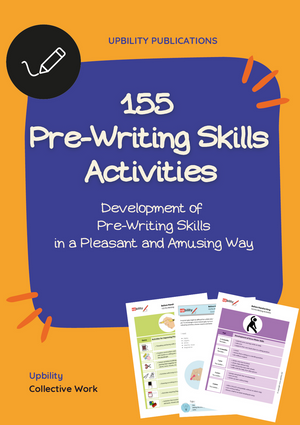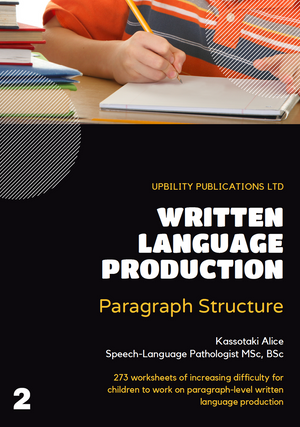
Development of Narrative Discourse
Narrative discourse
is the narration, written or oral, of an event or series of events, real or imaginary. The narration is organized in function of the spatial-temporal context, but also following cause and effect logic.
Organization. This is the manner in which the narrative discourse is organized. It is organized around the three following sections:
- Beginning: presentation of characters and spatial-temporal context,
- Middle: episode(s) (triggering events/initial action, twists, outcome/solution),
- End: final situation (result, the narrator’s thoughts on the story told).
Coherence. The coherence of a narrative text is ensured by the proper organization of the narration, but also through the use of adequate, logical connections. More specifically, it is possible through:
➡ Connections such as prepositions, adverbs and expressions that indicate the time, cause, consequence, opposition, additions, explanations, examples, hypotheses, confirmations, conclusions, etc.
➡ Repetition of expressions or words to emphasize what is being said.
➡ The use of pronouns to enrich the narrative and avoid repetition.
Linguistic characteristics of narrative discourse. The phrases are connected by words (first, next, later, finally, etc.) or expressions that indicate temporal succession, but they also include terms that specify the causal relationship (for example: because, since, as, due to, etc.).
The verbs in the narrative generally indicate action (for example: to run, to fall, to go, to meet, etc.) or reflection and emotion (to think, to believe, to dream, to feel, to experience, to rejoice, to be sorry, to fear, etc.).
These verbs are generally conjugated in the past tense: imperfect or simple past tense. The tense of the narration is, ideally, the simple past tense (also known as the preterite).
Phases of the Development of Narrative Discourse
1. Juxtaposed element phase - 2 years
This is the phase during which the child juxtaposes a series of objects and ideas based on immediate perceptions, without organization (macrostructure) and with little or no connection between phrases. The stories produced are an accumulation of phrases. This phase represents the beginning of the development of discourse (McCabe & Rollins, 1994). The child can express a series of ideas without any connection between them, unlike an adult, who establishes causal and chronological relationships between the events. An adult applies a macrostructure; he/she follows a narrative outline.
Children of two years of age mainly recount actions and utilize action verbs. 2.
Sequence phase - 2 to 3 years
This phase is characterized by the presence of simple macrostructures, focused on a central character or element in the context, but not on the plot. Despite the application of “sequences,” stories of this kind include events that are not necessarily connected to one another, either chronologically or through a causal relationship.
The sequence is brief and composed, in general, of known events. The story includes a main character, the subject or the context. The phrases utilized have a simple structure and present precise actions (verbs), providing information that is brief but clear. Causes and motivations are generally absent.
3. Pre-narration phase - 3 to 4 years
In this phase, the story has a core: a main character, an object or an event. Contrary to the sequence phase, the elements of pre-narration are in logical agreement with the characteristics of this core, or central theme. Therefore, a vilain does something bad and is punished, while the hero does something good and, typically, is rewarded. This is the phase where a conclusion starts to appear in the stories: an action leads to an emotion or a feeling, which results in an event. The goal is that a story is maintained, but the problems are not yet resolved (Garnett, 1986).
The pre-narration, like the sequence, includes a main character, a subject or a context. The story is organized around a central theme, by adding information or events. These elements begin to appear between the age of three and five years (Owens, 2010). The main difference between this phase and the sequence phase is what the child says about the character, his/her facial expressions or mannerisms. In addition, names begin to appear in the story.
4. Non-thematic chain of events phase - 4 to 4 and a half years
In this phase, there is no main character or main subject, and therefore no macrostructure, but the isolated elements are connected: each has a connection with the following element. To tell a story, the child must be able to form a chain of events, explaining what happens and why it happens (Kemper & Edwards, 1986). These non-thematic chains of events do not include a main character; they consist of a sequence of chronologically or causally linked actions. The elements around which a story is usually based, like the character, context or the action, change; thus, the story does not have a central theme.
The connectors “and,” “but” and “because” appear in these stories; children must be capable of narrating a complete episode. They begin to speak about common experiences and are able to comment on mental states - their own as well as those of others - and understand cause and effect relationships using various logical connectors. Their action is limited when they are asked to imagine a story, as they are not used to complex motivations.
5. Thematic chain of events phase - 5 years
This phase includes the combination of a character or central theme with a real sequence of events. However, the events do not depend on the characteristics of the character and the characters do not have motivations to reach a goal. In addition, stories of this kind often have a sudden “ending.”
The development of episodes in the form of well-constructed stories takes place around 5 years of age. At this age, the child can tell funny stories, with episodes, a context and results.
Thematic chains of events include a main character and a logical sequence of events. The stories are constructed around a character, who moves through a series of specific situations that are connected to one another (Owens, 2010). The events described are often in the form of an “adventure” and the listener must interpret the end.
6. Narrative phase - 6 years
The resulting stories have a central theme, a main character and a plot. In this phase, the stories include five parts: an initial occurrence, a motivation, an effort or an action, a consequence and a solution to the problem. They include elements that explain the motivations of the characters; in addition, the events follow causal or temporal logic. Preschool-aged children show an understanding of the structure of a story when the context is sufficiently clear. As they grow, they begin to connect the events; the narrations become longer, with complex syntactic structures, as well as an emerging series of connections. However, this only occurs when they begin school at the age of 6 years. They learn to tell stories about the “personal life” of the characters, as well as showing personal responses (Kemper, 1984, Roth & Spekman, 1987, Westby, 1991). The resulting stories are organized; their structure follows the story model.
Advice for the development of narrative discourse in preschool and school-aged children
When one studies the evolution from one grade to another, one notes that the development of narrative ability is indispensable. Below, you will find several pieces of advice organized according to grade level:
In preschool:
With the appropriate encouragement and support, the child can recognize the characters, context (when, where) and important events in a story.
In 1st grade:
Describe the characters, the context (spatial-temporal situation) and important points in a story by utilizing several basic facts.
In 2nd grade:
Explain how the characters in a story react to important events and challenges.
In 3rd grade:
Describe the characters in a story (their characteristics, motivations, emotions and feelings) and explain how their actions contribute to the progression of the story.
In 4th grade:
Precisely describe a character, the context or an event in a story, based on the specific details of the text (thoughts, words and actions of the characters). In 5th grade:
Compare and contrast two characters or more, within the location or events in a story, based on the specific details of the text (how the characters interact).
In 6th grade:
Describe how, in a given story, the plot advances in a series of episodes, and how the characters react or change as the story approaches a resolution.
From 4 to 8 years of age, the narrative ability of children improves; little by little the stories they tell take the form of a story. They become longer and more detailed. It is easier to understand “where and when” they occur and “who” they concern, but also to understand the events that take place. At this age (from 4 to 8 years), children learn to:
➡ Correctly use different logical connectors, such as “when,” “so,” “now,” “before,” “while” and “however.”
➡ Create connections between events and explain their causes or their consequences (for example: “The boat sank, so all the passengers had to swim to shore”).
➡ Use different types of phrases to present the same information.
➡ Use the appropriate pronouns (for example: “he,” “she,” or “they”) instead of names, when the context makes it clear who is being referred to.
➡ Leave out less important details to focus on the structure and plot of the story.
The eBook “Development of Narrative Discourse” is intended for preschool- and school-aged children presenting difficulties in the development of narrative abilities. It includes a comprehensive method, as well as a series of different exercises to establish the understanding of narration and the structure of a story.
Suggested articles for parents:
- 10 Ways to Teach Your Child the Skills to Prevent Sexual Abuse
- Building Social Skills in Young Children!
- Inner Child Trauma
More Articles on Upbility.net
Mental Health Therapists Material
Special Needs Teachers
Autism/Asperger’s Syndrome
Free Poster Download "Stop Telling Children To Be Careful"
Suggested e Books on child Psychology
Social Skills e book:


